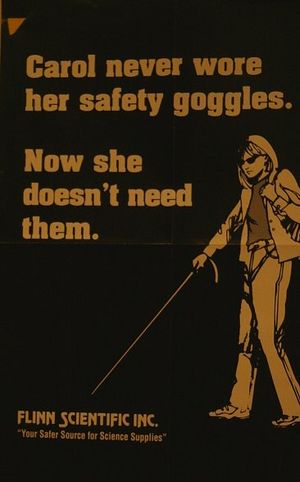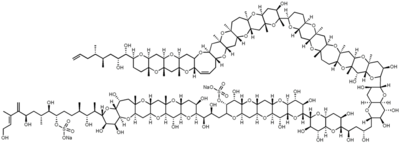User:Grayscale/Organic Chemistry
Organic Chemistry is the specific discipline within chemistry dealing with experiments that don't work. Originally, scientists thought that certain chemistry experiments and laboratory procedures that consistently went wrong must contain some fundamental essence of frustration, known as the "failure force" or "the stuff of fail." It is since been discovered that these experiments are exactly the same as those carried out in other branches of chemistry, they just constantly get bollixed up.
History[edit | edit source]
The theory of the "failure force" was first questioned by Friedrich Wöhler, a noted sadist, when in 1828 he managed to synthesize urea from ammonium cyanate. While he worked, glassware kept breaking, clamps kept coming loose, and chemicals kept inexplicably refusing to distill. Wöhler attempted his experiment 1,982 times before succeeding, despite starting from entirely inorganic materials. Afterwards he was still unwilling to conclude that the failure force was disproved, mostly because he was a little slow.
Progress in the field was gradual since no one wanted to subject themselves to the torture involved with organic research. Then in the 1920's it was discovered that drugs could be synthesized with organic reactions. Research skyrocketed since chemists could intoxicate themselves with the products of their experiments, providing added incentive. Bayer corporation, forcing their scientists to work with constant floggings and electrified fences, managed to artificially synthesize aspirin because they couldn't copyright things in their natural form. More recently, organic chemistry is known for creating a thriving amateur chemist community with laboratories springing up in basements and abandoned warehouses everywhere, manufacturing homemade products for recreation and urban renewal.

Organic Nomenclature[edit | edit source]
Most of the constant mishaps associated with organic chemistry have to do with the complexity of organic molecules. Organic molecules are based on the element carbon, which can form four sigma bonds, or two sigma and one pi bonds, or two pi bonds (getting confused yet?). This includes bonding with other carbon atoms to form sometimes comically large chains, rings, pentagrams, icosahedrons, and Bermuda Triangles. There are also multiple ways of arranging the same atoms to create chemicals with completely different properties. The result is that you could throw as many random atoms together as you want any way you want and as long as there are enough carbons in there you get a real molecule. In fact, that's exactly what organic chemists do all day, followed by huffing the results and seeing what happens.
The real fun begins when you try to name these infernal things. An entire language had to be invented to try to make sense of them - of course, this is organic we're talking about here, so needless to say it didn't work. Actually understanding organic nomenclature well enough to discuss it has proven to be a highly effective form of birth control, making someone sound so nerdy that no one of the opposite sex will venture within a country mile of the speaker. Just try talking about "2-Amino-2-(hydroxymethyl)-1,3-propanediol," "Cyclohexanecarboxaldehyde," "5,5-Dimethyl-1,3-cyclohexanedione," 4-[p-(nitrophenyl)azo]resocinol," or "Dimethylaminobenzaldehyde-p "[1] and not sound like you're possessed by the demon of geekatude.
Conformation of Murphy's Law[edit | edit source]
Before the development of organic chemistry, Murphy's Law was only Murphy's Theory, as although it had some support, it was not widely accepted by the scientific community. Various competing theories were also widely supported, including Bill's Theory (The probability of something going wrong is indirectly proportional to it's desirability), Frank's Theory (Stuff always goes wrong) and Uncle Tony's Theory (Look, I ain't sayin' somethin's gonna go wrong for you, all's I'm sayin' is, ya know, things go wrong). But an accurate model of exactly how things go wrong was not confirmed until organic chemists felt the constant, mind-numbing, soul-destroying, suicide-inducing frustration of their research.
Ritual Torture of Students[edit | edit source]
It didn't take long for the maddening reality of organic chemistry to sink in. Much like how a military trains soldiers for war, scientists decided that the only way to prepare students for the hell they were in for was to make the learning process as painful as possible. Common teaching practices include assigning lab wrightups that take no less than eight hours to finish, grading students on their first try performing complicated lab techniques that are prone to failure, and repackaging baby toys as "molecule kits" and calling them learning aids. Also, all safety goggles are ensured to be uncomfortably tight, fog up, and leave hideous marks on students faces.
But That's Not All![edit | edit source]
As if the failure rate of experiments and the absurd names of molecules were not already enough, most of organic chemistry makes use of solvents that are not only highly flammable, but poisonous and carcinogenic as well. The following is a list of common organic solvents and their health risks:
- Ethanol: Denatured, to prevent people from trying to drink it to dull the pain. Most eventually try anyway.
- Ether: Not denatured, so huff away!
- Hexane: Causes skin rashes of different colors depending on your mood. And cancer.
- Benzene: Contact causes random modification of genetic structure. Ingestion causes simultaneous projectile vomiting and diarrhea. And cancer.
- Methylene Chloride: Inhaling vapors leads to instant melting of the face and liquefying of the bones. Actually touching the stuff will cause you to be sucked through an interdimensional portal to the ninth layer of suck. And cancer.
If physical contact with any of these chemicals occurs, it is imperative that the unfortunate person immediately use the safety shower. It won't help, but it's nice to die clean.
Notes[edit | edit source]
- ↑ All real. No shit, I've seen them.


